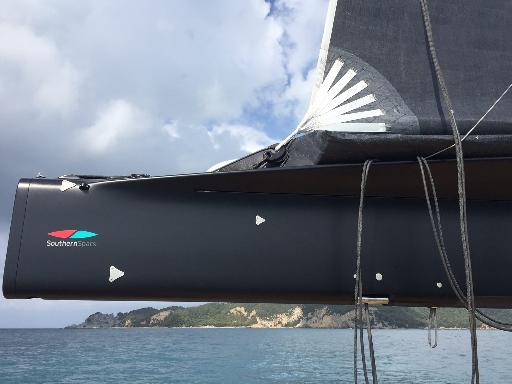Reducing mainsail area effectively is an essential aspect of depowering the boat as the wind strength increases. For offshore racing or cruising it is particularly important to be able to do so quickly and safely and this becomes even more critical when sailing shorthanded. Without weight on the rail, the need to reef comes earlier and the ability to deal with a situation is reduced. A mainsail reefing system should be reliable, quick to operate and produce an adequate sail shape once reefed. In this blog we discuss 4 options for taking a slab in the main.
Mainsail Reefing Types
Conventional Slab Reefing

Image credit: Calanach Finlayson
Perhaps the most common form of slab reefing is with a 2:1 reef line at the clew and a ram’s horn at the gooseneck. Reefing requires a crewmember to pull down on the luff and hook the reef cringle onto the ram’s horn. The luff is then tensioned on the halyard before cranking on the reef line. In the absence of a ram’s horn, a snap shackle can be lashed in position on a mast padeye or to the gooseneck.
Advantages:
- Only 1 line required per reef
- Minimal setup needed
- Independent control of luff tension and foot tension once reefed
Disadvantages:
- Requires a crew member venturing to the mast
Dual Line Reefing

Image credit: Harken
A dual line reef system replaces the hook or shackle at the gooseneck with an additional luff Cunningham line at every reef. Reducing sail area is done by lowering the mainsail, pulling down on the reef Cunningham and locking it off in a clutch or jammer. The halyard is then tensioned followed by the reef clew line as before. This is a good option for shorthanded racing or cruising, as long as you have enough space in the cockpit for all the lines and clutches.
Advantages:
- Reefing can be done from the cockpit
- Independent control of luff and foot tension once reefed
Disadvantages:
- Requires two lines and clutches for every reef
Single Line Reefing

Image credit: Barton Marine
A single line system is all about ease of use. Each reef has one line which runs from the cockpit, first to the tack and then along the boom to the clew. With the main halyard lowered, winding on the reef line simultaneously pulls down the luff and the clew.
Advantages:
- Easy to use
- Reefing can be done from the cockpit
- Only one line per reef
Disadvantages:
- Lots of line length to manage when taking reefs in and out
- Added friction
- No independent control over foot tension
- All the load is carried through one line
Reef Hook

Image credit: Karver Systems
A reef hook or lock is an alternative to all the methods listed above where the reef clew line is replaced by a locking mechanism. This system is typically only used on racing boats or performance cruisers over 45ft in order to reduce the compression in the boom and the number of loaded lines on clutches. To engage the reef the mainsail is lowered and first the clew hook is engaged. Then the luff is re-tensioned using the Cunningham / main halyard depending on the exact setup and whether there is also a main halyard lock.
Advantages:
- Reduced boom compression
- No highly loaded reef clew line in cockpit jammer
Disadvantages:
- Additional hardware cost can be high
- Foot tension pre-determined by hook position
Conclusion about Mainsail Reefing
Mainsail reefing requires pre-planning to configure a good system, and practice using it. Once setup well, it can be super straightforward to reduce sail area. The 4 options outlined in this blog each offer different benefits and drawbacks depending on your boat and style of sailing. In all cases, high quality components go a long way to making the system as efficient as possible. Ensure you have low friction blocks, good clutches/jammers and look for low stretch reef line with a durable grippy cover such as polyester/Technora.
If you have any questions about mainsail reefing, please feel free to email us at [email protected], or click the link below:


A Rough Guide to Mainsail Reefing